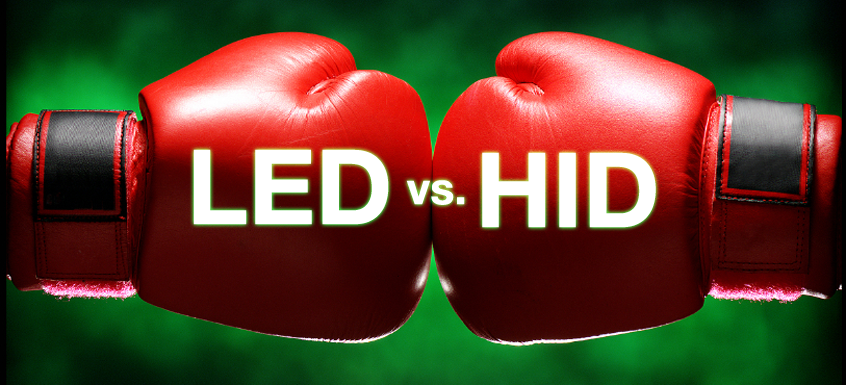Light Fights: LED vs. HID

LEDs have gotten a great deal of attention lately, but do they really have what it takes to outperform the tried-and-true favorites in the HID category? Let’s find out…
Applications
In the past, HID lights were often the go-to choice in applications where a large amount of visible light was needed in a sizeable area. For instance, they’re often found in streetlights, gymnasiums, stadiums, warehouses, and in high-ceilinged buildings. HID lights, however, are not a perfect solution as the light they produce isn’t always pleasing to the eye and many require an extended warm up time. Thanks to technological advancements, LEDs are now a viable alternative in many HID applications – although, they also come with their own set of pros and cons.
Overview
Before we get into the advantages and disadvantages of HIDs and LEDs, let’s first get a better idea of what we’re dealing with by reviewing how each light operates.
Light Emitting Diodes (LEDs)
Unlike incandescent bulbs, which use a filament, or CFLs, which rely on gas, LEDs create light by exciting electrons. Inside each LED bulb is a semiconductor material consisting of positively and negatively charged parts. When the light is turned on and an electricity strikes the semiconductor, electrons become charged and begin to flow from a negative to a positive layer within the semiconductor. As the excited electrons pass through “holes” in the material, they emit photons of light and cause the LED to illuminate.
High Intensity Discharge Light Bulbs (HID)
HIDs are a class of gas-discharge arc lamps that form light by transmitting an electrical current between two electrodes and an ionized gas. The light radiates from the arc when charged electrons change orbit as they interact with the gas. All is hermetically sealed inside a quartz glass capsule. Generally, an extra gas is also used, which helps to distinguish the main types of HIDs: sodium, mercury, and metal halide. Every HID requires a ballast to regulate its power and to create the initial surge of electricity that allows the light to start. These lamps are known for producing greater illumination than halogen bulbs while consuming less power.
Now for the pros and cons…
HIDs & LEDs Compared
|
HID |
LED |
|
| Energy Efficiency | 100+ Lumens/Watt (note: This is advertised lumens per watt, which isn’t always what it seems. Explanation below). | 100+ Lumens/Watt and constantly improving |
| Durability | Fragile – has moving parts, glass bulbs, and filaments | Heavy-duty – has no electrode or filament, shock & vibration resistant |
| Lifetime | 15,000 to 25,000 hours | 50,000 hours plus (many rated over 100,000 hours) |
| Lumen Depreciation | Moderately high | Rated life is the point which 30% of light is lost. LEDs will last much longer, but light output will continue to decrease over time. |
| Cold Tolerant | – 40 F | -30 F (instant on) |
| Performance | Requires 5-10 minute warm-up time, creates light in all directions | Turns on instantly, no flickering, ability to create focused light and omni-directional light |
| Color Temperatures | Few Options (3000 to 5000 Kelvin) | Multiple Options (2700 to 6500 Kelvin) |
| Color Rendering | 5 to 93 CRI | Average 80 to 95 CRI |
| Dimmable? | No | Most |
| Warranty | Usually 1 to 2 years | Typically 5 years |
| Cost | Lower upfront cost, but requires regular relamping and ballast replacement | High upfront cost but virtually no maintenance expenses |
As noted in the energy efficiency section of the chart, you can’t always take a lamp’s advertised lumens per watt (Lm/W) at face value. This is because there is no standardization in the labeling process, so some manufacturers may print the mean Lm/W while others list the initial Lm/W. The problem with making a purchasing decision based on the initial rating is that number can diminish over time, and other factors can also reduce a lamp’s efficiency.
For instance, while most HIDs appear extremely efficient, not all their lumens actually make it outside the lamp, as some of the light is trapped inside or reflected back from the protective covers. Efficiency also decreases in cold weather or when using ineffective ballasts. Furthermore, after 8,000 hours of use, most HID lamps will lose about 20% of their lumens per watt while LEDs will still be operating at nearly 100%.
The bottom line is, while HIDs may advertise 100+ Lm/W, most are lucky to get 60 Lm/W.
Solution
In this matchup, LEDs come out the winner in four major areas: efficiency, lifespan, durability, and low maintenance. However, there are still some instances where an HID is still a smart choice. For example, HIDs make sense for temporary low cost lighting, extreme high temperature applications, or if you want to match existing ballasts and fixtures that are still in good shape.
In conclusion, LED technology is advancing all the time and their benefits justify the higher upfront cost over HID lighting in most applications. Click the following link to view the latest and greatest in LED lighting.



LED is by far the longest lasting type of bulb. HID takes the win for brightness and color.
That’s just my .02 cents
you mean dollars you imbecile?
Smart speech from sewage’s man
Brightness will ALWAYS be won by LED. They are the only light that can trick your body into thinking it is daylight. With proper LED lights, you can provide a nap here in an office where people are actually awake and not need coffee to stay awake.
You didn’t mention that LED bulbs burn out fast if they get too hot, like in an enclosed space. That is a BIG problem with LEDs.
Jerod my led bulb died with in a month if use, you think i bought a fake one?
Hid hands down for the most important thing..VISIBILITY. I’ll take that over anything else.
I have a lifted old pick up and go out to wilderness frequently. Need a good headlight for visibility, brightness and broader span. Any suggestions folks?
If the Power company puts an outside LED on their pole and the LED runs 24/7, how
long will it take for the LED to start showing Less brightness
Hi sara,
It would take only around 2 days of continuous use before there was a noticeable brightness decrease.
Unbelievable….
1. HID’s have a MUCH wider color spectrum than LED’s hands down.
2. “2 days of continuous use….” will NOT make any difference in light output, if that were the case, then std. Halogens would be “noticeable” in 15 minutes…. really?
3. HID’s are a scatter light pattern. Since the glass bulb is spherical and clear it will emit light in all directions. LEDS are flat and tend to be directional. That being said, no one I am aware of puts them on the hood of a car. They are mounted in a reflective enclosure to focus the light. So, based on the reflective properties of the headlight enclosure, that will ultimately determine the light pattern and (to some degree) brightness.
4. LED’s do not get “hot” directly. They light emitting area is actually warm.. it is the electronics that CONTROL the input to the LED material that produces heat. The HID’s on the other hand, actually do get hot as the electron arc in the xenon gas produces a plasma and that is very hot. (think about the SUN.. hint).
This article is quite slanted towards LED as a primary choice. In fact, HID technology is quite mature and the quality of the bulbs and electronics have improved dramatically.
In defense of LED, the run cooler (heat wise) and much more efficient watt per lumen emitted, water proof and are dimmable…. (for the most part).
The Dimmable aspect is quite important in that most current cars use either high beam or low as the DRL’s during the day. They do this by either a voltage / current reduction to around 50% (or less) of the normal full power to reduce light output on a standard halogen system.
HID’s must have full power to work, less than full will created a flicker, blinking, or not even come on and potentially damage the ballast.
LED’s can handle voltage reductions / fluctuations and most come STD with CANBUS electronics that compensate for the systems that use it.
In summation, it really depends on your application. For me, I use HIS’s in my low beams as they are constant on full power and I use LED’s in my HIGH beams where they are the ones that dime for DRL’s in the day …. as well as being INSTANT ON, so when I need HIGH BEAM, I get them, with out delay.
LED lights for autos are brighter more pure white light vs. HID blue purple etc. you stair at HID lights it Blinds you but stairing into LED lights you see spots afterwards. LED uses a 1/3 of the juice a incandescent or HID bulb would. You could leave your lights on all night with LEDs and the battery has a better chance starting the vehicle! HID you do hat with and it won’t start next day! HIDs don’t blind as bad as a LED bulb seems to. LEDs are better all the way around than old technology’s HID bulbs would be.
your comparing apples to oranges. HID dont start emitting blue spectrum until you go higher then 6k. 6k ultra white looks identical on road and to drivers as a 6k color LED. HID run at 120 lumens/watt as opposed to LED 30 lumen/watt, but even HID are more efficient than hallogen and incadescent, so either one is more efficient than old tech…..HID’s are not “old technology” They are older than lED, but make no mistake. modern HID tech is just as advanced as anything else within the last several years, and companies are still creating updated and improved variants. If you get a HID set from the early 2000’s, thats your own fault. Also, your not taking into account flux. Lumen is the raw light output, (which many LED excell at) but FLUX is the actual usable light, or the throw of the light. HID has better flux vs LED, so more light gets put down the road
This past Saturday I was all set to retrofit our parking lot lights from HID to LED. When I got to the top of the first pole with the lift I saw that the LED bulbs that were spec’d were incorrect (Satco S9394’s), my mistake I didn’t check. So quick as I could I found a few “direct replacement” LEDs (S9391) for the existing 100 watt HIDs. I only did a few fixtures as a trial. I think the existing HID’s are 4000K, the LEDs are 5000K. I like the LED color a lot, but I have to say the so called “direct replacement” lumens are a joke. The existing HIDs cast deep shadows into the LED light field, so HIDs obviously much brighter. These LEDs have to be reflected too, they are omni-directional. For reference, the HID lumens 10,000, the LED lumens 2750. The other thing to note is the LEDs are very big, so without replacing the fixture I can’t go any larger with the LED. Seems like 99% of what you see on the internet is pure LED hype, OK I’ll calm down and be more reasonable in a day or two.